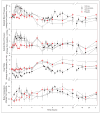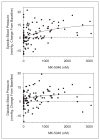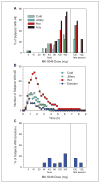Pharmacokinetics and pharmacodynamics of MK-5046, a bombesin receptor subtype-3 (BRS-3) agonist, in healthy patients
- PMID: 22162541
- PMCID: PMC5137193
- DOI: 10.1177/0091270011419854
Pharmacokinetics and pharmacodynamics of MK-5046, a bombesin receptor subtype-3 (BRS-3) agonist, in healthy patients
Abstract
MK-5046 is an orally active, potent, selective agonist of the orphan G protein-coupled receptor bombesin receptor subtype-3 (BRS-3) that is under evaluation for treatment of obesity. We report the safety, tolerability, pharmacokinetics, and pharmacodynamics of oral doses of MK-5046 (10-160 mg) in a double-blind, randomized, placebo-controlled study in healthy and obese male volunteers. MK-5046 exposure increased dose proportionally, and MK-5046 was eliminated with an apparent terminal half-life of 1.5 to 3.5 hours. Single doses transiently increased blood pressure. Patients reported adverse events (erections and feeling hot, cold, and/or jittery) that coincided with time of occurrence (T(max)) and increased with increasing dose. No changes were observed in body temperature, heart rate, plasma glucose levels, or feelings of hunger/satiety. The blood pressure and thermal experiences attenuated with a second dose 6 hours after the first. Additionally, the erections suggest a possible, unanticipated, role for BRS-3 in reproductive physiology. Oral administration of MK-5046 achieves plasma concentrations that are projected to activate BRS-3 and therefore should be suitable for exploring its biological role in humans.
Figures





Similar articles
-
Antiobesity effect of MK-5046, a novel bombesin receptor subtype-3 agonist.J Pharmacol Exp Ther. 2011 Feb;336(2):356-64. doi: 10.1124/jpet.110.174763. Epub 2010 Oct 29. J Pharmacol Exp Ther. 2011. PMID: 21036912
-
The Nonpeptide Agonist MK-5046 Functions As an Allosteric Agonist for the Bombesin Receptor Subtype-3.J Pharmacol Exp Ther. 2022 Aug;382(2):66-78. doi: 10.1124/jpet.121.001033. Epub 2022 May 29. J Pharmacol Exp Ther. 2022. PMID: 35644465 Free PMC article.
-
Safety, tolerability, pharmacokinetics, and pharmacodynamic properties of taranabant, a novel selective cannabinoid-1 receptor inverse agonist, for the treatment of obesity: results from a double-blind, placebo-controlled, single oral dose study in healthy volunteers.J Clin Pharmacol. 2008 Apr;48(4):418-27. doi: 10.1177/0091270008314467. Epub 2008 Feb 7. J Clin Pharmacol. 2008. PMID: 18258750 Clinical Trial.
-
Biology and pharmacology of bombesin receptor subtype-3.Curr Opin Endocrinol Diabetes Obes. 2012 Feb;19(1):3-7. doi: 10.1097/MED.0b013e32834ec77d. Curr Opin Endocrinol Diabetes Obes. 2012. PMID: 22157398 Review.
-
Appetite-modifying effects of bombesin receptor subtype-3 agonists.Handb Exp Pharmacol. 2012;(209):405-32. doi: 10.1007/978-3-642-24716-3_19. Handb Exp Pharmacol. 2012. PMID: 22249826 Review.
Cited by
-
Altered gut and adipose tissue hormones in overweight and obese individuals: cause or consequence?Int J Obes (Lond). 2016 Apr;40(4):622-32. doi: 10.1038/ijo.2015.220. Epub 2015 Oct 26. Int J Obes (Lond). 2016. PMID: 26499438 Free PMC article. Review.
-
Cre Recombinase Driver Mice Reveal Lineage-Dependent and -Independent Expression of Brs3 in the Mouse Brain.eNeuro. 2021 Aug 17;8(4):ENEURO.0252-21.2021. doi: 10.1523/ENEURO.0252-21.2021. Print 2021 Jul-Aug. eNeuro. 2021. PMID: 34326065 Free PMC article.
-
Insights into bombesin receptors and ligands: Highlighting recent advances.Peptides. 2015 Oct;72:128-44. doi: 10.1016/j.peptides.2015.04.026. Epub 2015 May 11. Peptides. 2015. PMID: 25976083 Free PMC article. Review.
-
Receptor-specific crosstalk between prostanoid E receptor 3 and bombesin receptor subtype 3.FASEB J. 2018 Jun;32(6):3184-3192. doi: 10.1096/fj.201700337RR. Epub 2018 Jan 22. FASEB J. 2018. PMID: 29401613 Free PMC article.
-
Bombesin-like receptor 3 regulates blood pressure and heart rate via a central sympathetic mechanism.Am J Physiol Heart Circ Physiol. 2016 Apr 1;310(7):H891-8. doi: 10.1152/ajpheart.00963.2015. Epub 2016 Jan 22. Am J Physiol Heart Circ Physiol. 2016. PMID: 26801314 Free PMC article.
References
-
- Bray GA. Medical consequences of obesity. J Clin Endocrinol Metab. 2004;89(6):2583–2589. - PubMed
-
- World Health Organization. [September 7, 2011];Obesity and overweight. 2006 Available at: http://www.who.int/mediacentre/factsheets/fs311/en/index.html.
-
- Sjostrom L, Lindroos AK, Peltonen M, et al. Lifestyle, diabetes, and cardiovascular risk factors 10 years after bariatric surgery. N Engl J Med. 2004;351(26):2683–2693. - PubMed
-
- Smith BR, Schauer P, Nguyen NT. Surgical approaches to the treatment of obesity: bariatric surgery. Endocrinol Metab Clin North Am. 2008;37(4):943–964. - PubMed
-
- Torgerson JS, Hauptman J, Boldrin MN, Sjostrom L. XENical in the prevention of diabetes in obese subjects (XENDOS) study: a randomized study of orlistat as an adjunct to lifestyle changes for the prevention of type 2 diabetes in obese patients. Diabetes Care. 2004;27(1):155–161. - PubMed
Publication types
MeSH terms
Substances
Grants and funding
LinkOut - more resources
Full Text Sources
Molecular Biology Databases

